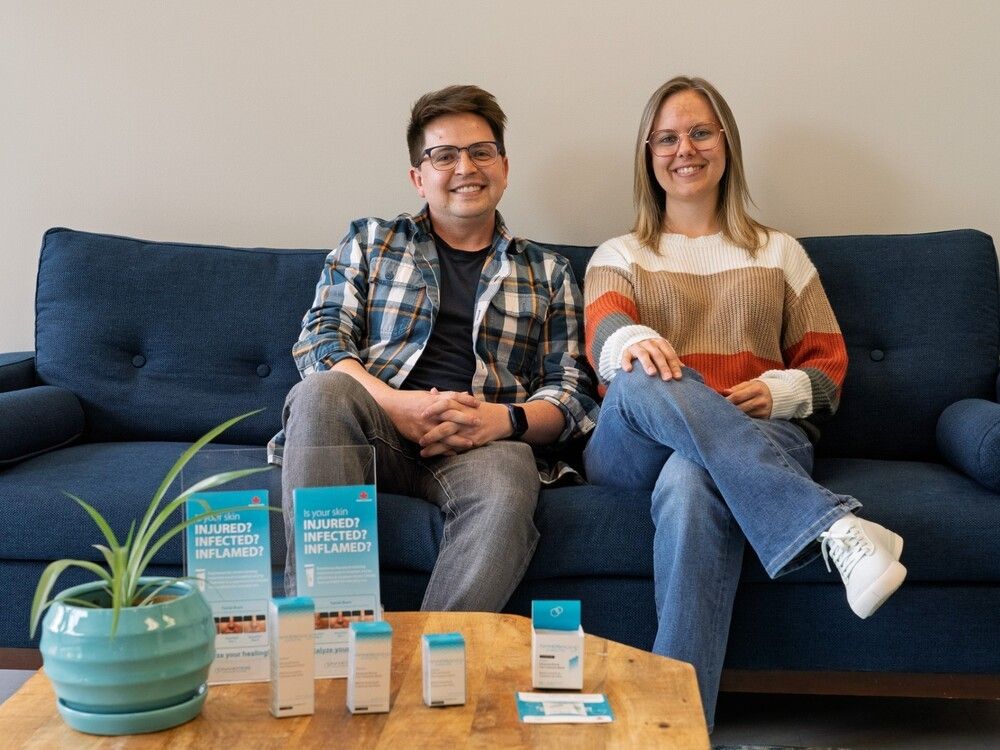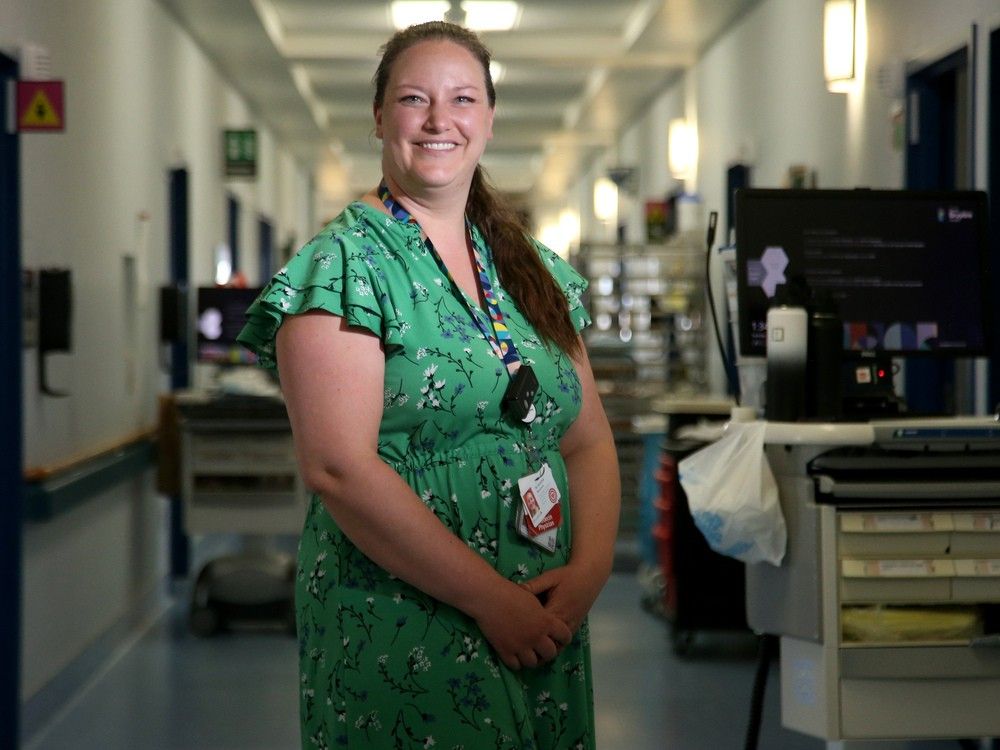Nancy Johnson was skeptical when her doctor asked if she would try a new treatment for a wound that had not healed in years. She had reason to be.
The 74-year-old Ottawa woman had been in hospital for more than two years with a surgical wound that became infected and did not heal. Adverse reactions to antibiotics and treatments complicated her care. She eventually ended up at Bruyère Health-Saint Vincent Hospital’s special unit for patients with the most complex non-healing wounds.
Specialists had used every treatment they could on the chronic abdominal wound that had become a barrier to improving Johnson’s overall health and getting her out of the hospital.
Every second day she endured up to 45 minutes of sometimes painful dressing changes and treatments. But there was little improvement.
Johnson, who spends her days reading, talking to family members and watching television in her hospital room, describes herself as a “glass half-full person.” But, like many patients living with chronic wounds, she had little expectation that things would improve any time soon.
Still, she agreed to be part of a quality improvement project involving a wound-healing salve created by a Calgary health tech company.
That company, NanoTess Inc., describes the treatment as “a Health Canada-authorized medical device in the form of a liquid matrix that facilitates wound healing using catalytic technology.” It is a gel that transforms into a film, like a liquid bandage, that contains catalytic technology — which allows healing reactions to happen better and faster. Officials say they are not aware of any products in Canada using similar technology to heal wounds.
The product had been attracting attention and raising hope in an area of health care in which hope is often in short supply and innovation is desperately needed.
Dr. Katrina DeZeeuw, who treats patients with chronic wounds at Bruyère, admits she was also skeptical when the hospital’s innovation team suggested she try the new product on patients with non-healing wounds for four weeks to see if it made a difference.
“In chronic wounds, changes don’t often happen fast,” DeZeeuw said. “If you take a wound that has been the same for a year and you are trying something on it and only giving it four weeks, I was worried that wouldn’t be enough time.”
She knew there was no such thing as a “magic cure” for the complex patients she saw daily.
For most people, cuts and wounds heal in a matter of days or weeks. But in some patients, especially those who are older or have other chronic conditions such as diabetes or poor circulation, healing can take significantly longer and unhealed wounds can become chronic, prone to infection, and even life-threatening.
DeZeeuw began using the salve on eight patients, choosing those “with the most challenging wounds I have in my patient population.” The patients all had wounds that had been present for at least one year and as long as three years. There had been no improvement for at least six to 12 months. Johnson was among them.
After four weeks, something surprising happened. For most patients, the complex wounds began to look — and feel — different. DeZeeuw wasn’t expecting to see 100 per cent healing in just four weeks, but what she saw through careful tracking was encouraging.
On average, the wounds in those patients decreased in size by 26 per cent. Half of the patients saw their wounds decrease by between 30 and 47.5 per cent in four weeks. One patient, who experienced extreme pain every time her dressings were changed, no longer felt pain.
After the initial four weeks, DeZeeuw continued using the treatment on five patients. Treatment was stopped on two others who had seen no improvement, and one patient died of unrelated causes.
After eight weeks, the changes were even more profound. The average improvement was 49 per cent. Some wounds improved by as much as 80 per cent.
Johnson’s chronic wound was 24 per cent smaller after four weeks and 30 per cent smaller at eight weeks — the first significant change seen in years.
“I am really hopeful. These are really promising results,” DeZeeuw said. “I am looking for the 100 per cent healed, and I wasn’t expecting to see that in four weeks. But I am very hopeful that we will start to see those fully healed wounds.”
Those are the kinds of results that have been seen elsewhere in Canada where the product is being used.
In one case, a pressure injury that had been open for 13 years healed after being treated with the product for almost a year.
To some extent, chronic wounds are the dark secret of the health system. They can be devastating to patients and their families and cost the health care system billions every year. But they are not widely talked about.
There are no colourful ribbons or lavish fundraisers to raise money and awareness, but they have an oversized impact on patients, their families and the health system as a whole.
The non-profit organization Wounds Canada calls them a silent epidemic.
Wound care costs the Canadian health system $12 billion a year, according to Wounds Canada. The non-profit organization estimates that between 30 and 50 per cent of all health care involves treating wounds. That includes half of all nursing visits delivered in the community. And home care is generally unable to meet the demand.
In a letter to Prime Minister Mark Carney in May, Wounds Canada CEO Mariam Botros urged the new government to invest more money in wound care, making sure it was available to all Canadians. She called it “a 12-billion-dollar-a-year health and quality of life issue that will affect everyone in Canada at some point in their lives.” Better funding for training, supplies and preventative care would save Canada money in the long run, the organization says.
It could also change lives. Chronic wounds have been a scourge of health care for millennia; signs of pressure sores have been found in Egyptian mummies, Florence Nightingale reportedly said that a bed sore was “generally not the fault of the disease, but of nursing.” Still, chronic wounds continue to keep millions of patients in hospital, in treatment, in discomfort and at risk.
Doing something to change the trajectory of chronic wounds became a mission of Julian Mulia, a chemical engineer originally from Mexico, who was inspired to look for solutions after losing both parents to chronic conditions, including managing wounds. He is chief operating officer of Calgary-based NanoTess. Co-founder Megan Leslie is CEO.

The company describes its salve as a catalyst that uses the body’s natural healing reactions to promote faster healing and reduce inflammation.
“Essentially, when a body is trying to heal a wound, it’s like pushing a rock up a mountain. And a lot of us don’t of the energy or resources to help make that (healing) reaction go to completion, which is where you get into chronic wound territory and your body just can’t heal itself,” said Larissa Lalonde, strategy lead at the company.
What the salve does, Lalonde said, is lower the energy it takes to heal the wound “so that more of those healing reactions can take place faster and better.”
During a provincial commercialization project funded by the CAN Health Network and conducted by Alberta Health Services and the University of Calgary, integrating the product into treatment improved wound healing in chronic wounds by 57.6 per cent. Those were wounds that had not healed for an average of more than one and a half years.
Bruyère, which has the largest specialty wound treatment unit as well as the only complex care facility in eastern Ontario, is also part of the CAN Health Network, a federally funded agency that supports Canadian health-care innovation. Based on validation by the Alberta Health Service, it tried out the product earlier this year, and it now plans to expand its use, DeZeeuw said.
“My goal is to get it throughout Bruyère Health,” she said. “It has the potential to really help a lot of people.” Other nearby hospitals and long-term care homes are also looking at it, she said, and it is being used across Canada.
“To my knowledge, there has not been a really significant breakthrough that has kind of flipped wound care on its head — at least since I have been in medical training,” DeZeeuw said. “I am hopeful that this ends up being really helpful for at least a significant proportion of patients.”
That includes many people in hospital beds and long-term care homes across the country suffering from chronic bed sores, diabetic foot ulcers and complex surgical incisions. In some cases, chronic wounds are keeping them bedridden or away from their homes and families.
“Often you suffer alone if you are dealing with a wound,” said Lalonde of NanoTess. “It is not something that people typically talk openly about. But, when you do start to talk about it with friends or family, you realize how widespread this issue is.”
The company was developed as a social enterprise “committed to providing catalyzing healing for all.” That includes making sure the treatment is affordable and easy to use. The company also works with homeless and other underserved populations who experience wounds.
“Our mission is to leave no one behind,” Lalonde said.
The product is also available behind the counter at pharmacies across the country to treat all kinds of wounds.
For patients like Johnson and others with chronic wounds, it represents a new chance to heal and, maybe a light at the end of a long tunnel.
“In the last little while, I have noticed more of a change,” Johnson said. “It is still going to take a while, but it is getting better.”
Join us! The Ottawa Citizen is hosting an exclusive food and beverage tasting event where you can try bites from some of the city’s best restaurants and sample beverages from breweries and wineries. Meet the chefs and try their signature dishes with members of the Citizen news team. Learn more about Ottawa Citizen Best Restaurants and buy a ticket
here
.
Related
- Ontario hospitals are doing more with less, but at a cost
- ‘I’m going to save a life’: Ripple effect of a pioneering organ donor saves baby in need



